Battery MITSUBISHI 380 2005 Service Manual
[x] Cancel search | Manufacturer: MITSUBISHI, Model Year: 2005, Model line: 380, Model: MITSUBISHI 380 2005Pages: 1500, PDF Size: 47.87 MB
Page 263 of 1500
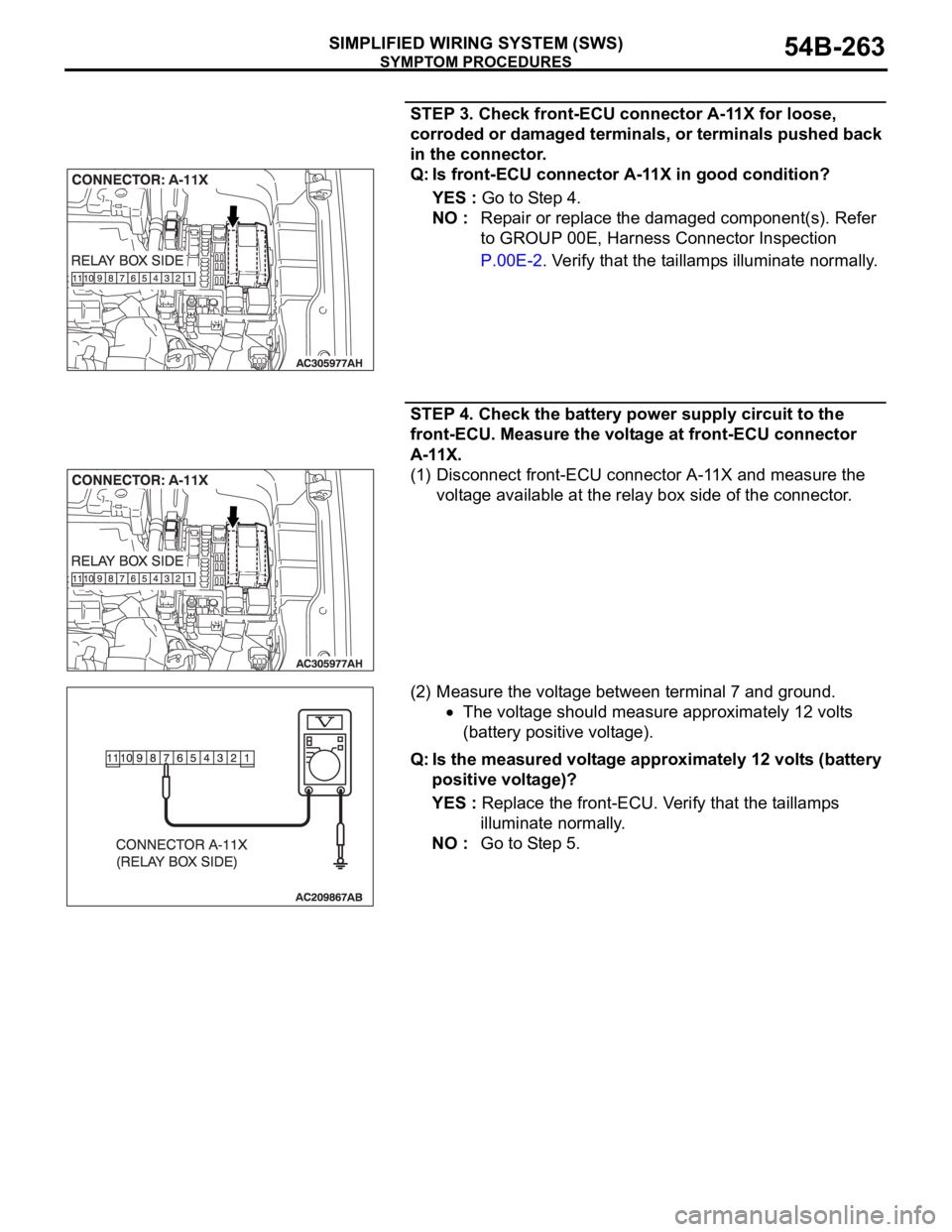
SYMPTOM PROCEDURES
SIMPLIFIED WIRING SYSTEM (SWS)54B-263
STEP 3. Check front-ECU connector A-11X for loose,
corroded or damaged terminals, or terminals pushed back
in the connector.
Q: Is front-ECU connector A-11X in good condition?
YES : Go to Step 4.
NO : Repair or replace the damaged component(s). Refer
to GROUP 00E, Harness Connector Inspection
P.00E-2. Verify that the taillamps illuminate normally.
STEP 4. Check the battery power supply circuit to the
front-ECU. Measure the voltage at front-ECU connector
A-11X.
(1) Disconnect front-ECU connector A-11X and measure the
voltage available at the relay box side of the connector.
(2) Measure the voltage between terminal 7 and ground.
The voltage should measure approximately 12 volts
(battery positive voltage).
Q: Is the measured voltage approximately 12 volts (battery
positive voltage)?
YES : Replace the front-ECU. Verify that the taillamps
illuminate normally.
NO : Go to Step 5.
Page 264 of 1500
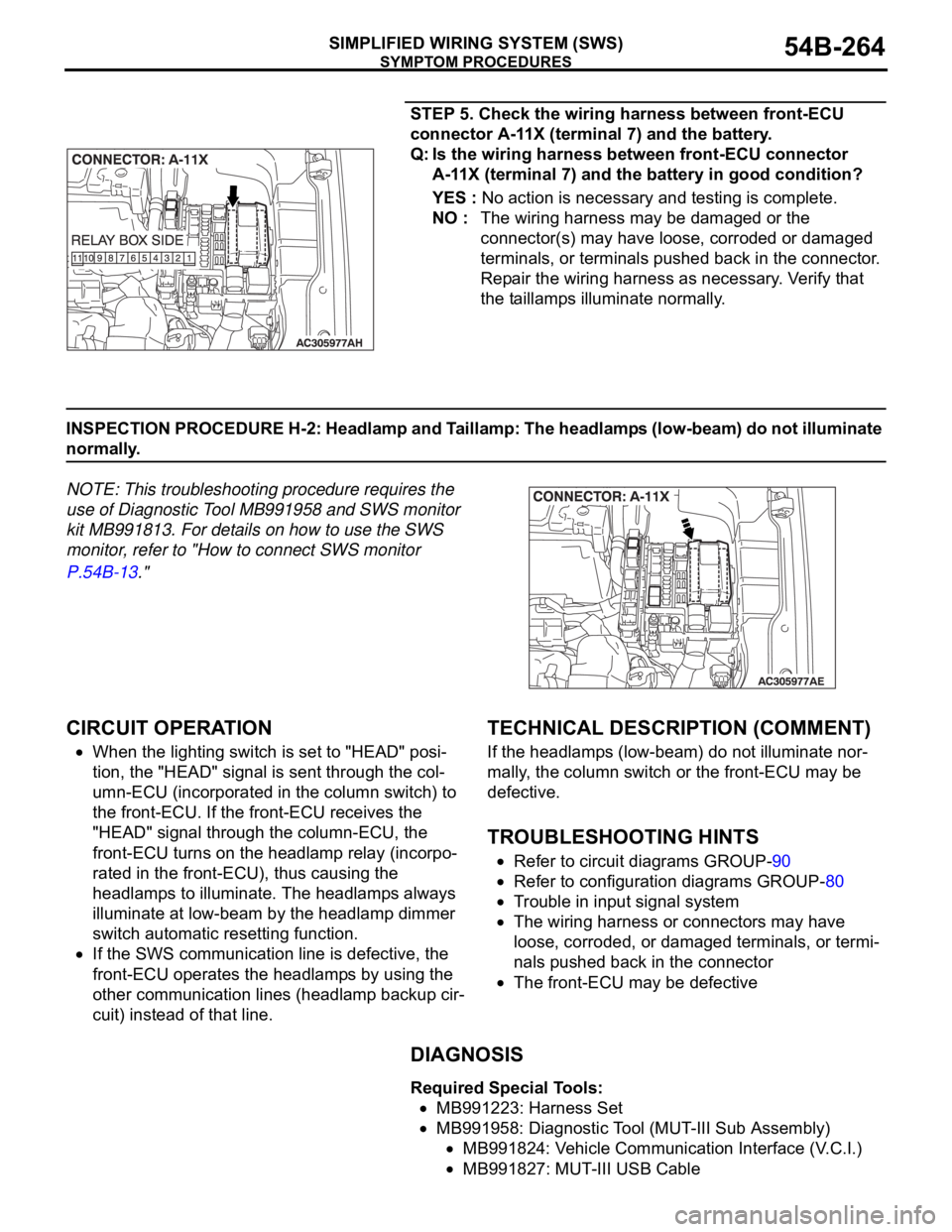
SYMPTOM PROCEDURES
SIMPLIFIED WIRING SYSTEM (SWS)54B-264
STEP 5. Check the wiring harness between front-ECU
connector A-11X (terminal 7) and the battery.
Q: Is the wiring harness between front-ECU connector
A-11X (terminal 7) and the battery in good condition?
YES : No action is necessary and testing is complete.
NO : The wiring harness may be damaged or the
connector(s) may have loose, corroded or damaged
terminals, or terminals pushed back in the connector.
Repair the wiring harness as necessary. Verify that
the taillamps illuminate normally.
INSPECTION PROCEDURE H-2: Headlamp and Taillamp: The headlamps (low-beam) do not illuminate
normally.
NOTE: This troubleshooting procedure requires the
use of Diagnostic Tool MB991958 and SWS monitor
kit MB991813. For details on how to use the SWS
monitor, refer to "How to connect SWS monitor
P.54B-13."
.
CIRCUIT OPERATION
When the lighting switch is set to "HEAD" posi-
tion, the "HEAD" signal is sent through the col-
umn-ECU (incorporated in the column switch) to
the front-ECU. If the front-ECU receives the
"HEAD" signal through the column-ECU, the
front-ECU turns on the headlamp relay (incorpo-
rated in the front-ECU), thus causing the
headlamps to illuminate. The headlamps always
illuminate at low-beam by the headlamp dimmer
switch automatic resetting function.
If the SWS communication line is defective, the
front-ECU operates the headlamps by using the
other communication lines (headlamp backup cir-
cuit) instead of that line.
.
TECHNICAL DESCRIPTION (COMMENT)
If the headlamps (low-beam) do not illuminate nor-
mally, the column switch or the front-ECU may be
defective.
.
TROUBLESHOOTING HINTS
Refer to circuit diagrams GROUP-90
Refer to configuration diagrams GROUP-80
Trouble in input signal system
The wiring harness or connectors may have
loose, corroded, or damaged terminals, or termi-
nals pushed back in the connector
The front-ECU may be defective
DIAGNOSIS
Required Special Tools:
MB991223: Harness Set
MB991958: Diagnostic Tool (MUT-III Sub Assembly)
MB991824: Vehicle Communication Interface (V.C.I.)
MB991827: MUT-III USB Cable
Page 267 of 1500
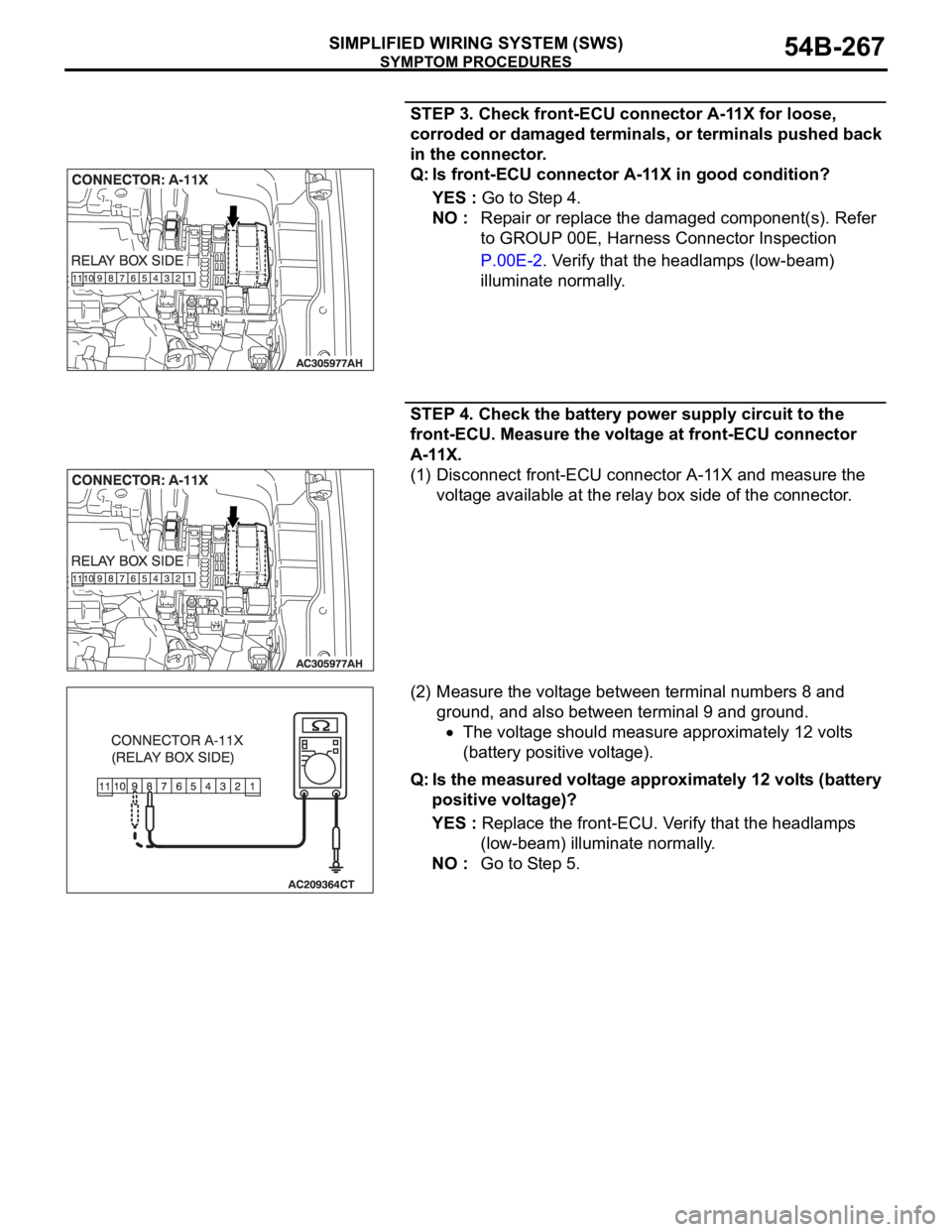
SYMPTOM PROCEDURES
SIMPLIFIED WIRING SYSTEM (SWS)54B-267
STEP 3. Check front-ECU connector A-11X for loose,
corroded or damaged terminals, or terminals pushed back
in the connector.
Q: Is front-ECU connector A-11X in good condition?
YES : Go to Step 4.
NO : Repair or replace the damaged component(s). Refer
to GROUP 00E, Harness Connector Inspection
P.00E-2. Verify that the headlamps (low-beam)
illuminate normally.
STEP 4. Check the battery power supply circuit to the
front-ECU. Measure the voltage at front-ECU connector
A-11X.
(1) Disconnect front-ECU connector A-11X and measure the
voltage available at the relay box side of the connector.
(2) Measure the voltage between terminal numbers 8 and
ground, and also between terminal 9 and ground.
The voltage should measure approximately 12 volts
(battery positive voltage).
Q: Is the measured voltage approximately 12 volts (battery
positive voltage)?
YES : Replace the front-ECU. Verify that the headlamps
(low-beam) illuminate normally.
NO : Go to Step 5.
Page 268 of 1500
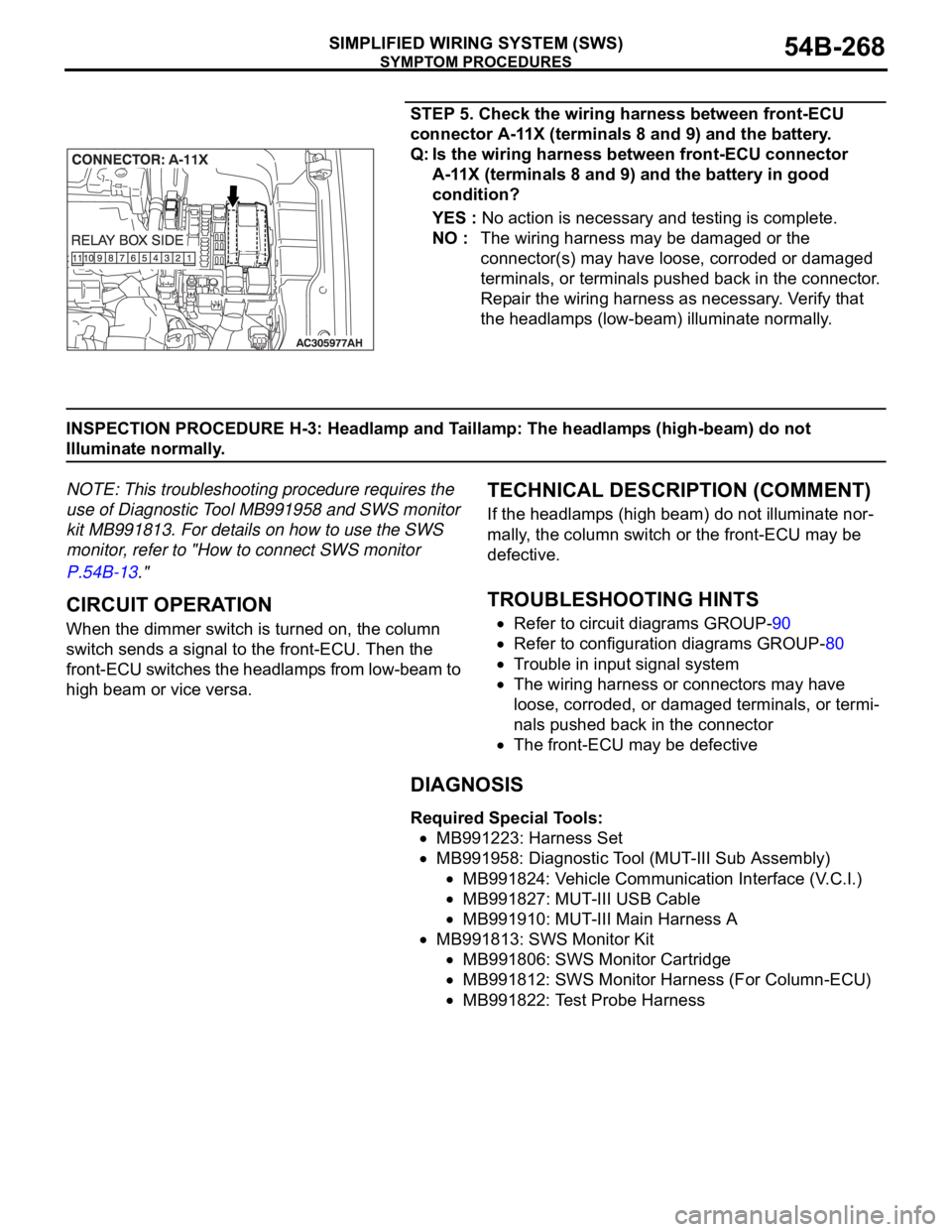
SYMPTOM PROCEDURES
SIMPLIFIED WIRING SYSTEM (SWS)54B-268
STEP 5. Check the wiring harness between front-ECU
connector A-11X (terminals 8 and 9) and the battery.
Q: Is the wiring harness between front-ECU connector
A-11X (terminals 8 and 9) and the battery in good
condition?
YES : No action is necessary and testing is complete.
NO : The wiring harness may be damaged or the
connector(s) may have loose, corroded or damaged
terminals, or terminals pushed back in the connector.
Repair the wiring harness as necessary. Verify that
the headlamps (low-beam) illuminate normally.
INSPECTION PROCEDURE H-3: Headlamp and Taillamp: The headlamps (high-beam) do not
Illuminate normally.
NOTE: This troubleshooting procedure requires the
use of Diagnostic Tool MB991958 and SWS monitor
kit MB991813. For details on how to use the SWS
monitor, refer to "How to connect SWS monitor
P.54B-13."
.
CIRCUIT OPERATION
When the dimmer switch is turned on, the column
switch sends a signal to the front-ECU. Then the
front-ECU switches the headlamps from low-beam to
high beam or vice versa.
.
TECHNICAL DESCRIPTION (COMMENT)
If the headlamps (high beam) do not illuminate nor-
mally, the column switch or the front-ECU may be
defective.
.
TROUBLESHOOTING HINTS
Refer to circuit diagrams GROUP-90
Refer to configuration diagrams GROUP-80
Trouble in input signal system
The wiring harness or connectors may have
loose, corroded, or damaged terminals, or termi-
nals pushed back in the connector
The front-ECU may be defective
DIAGNOSIS
Required Special Tools:
MB991223: Harness Set
MB991958: Diagnostic Tool (MUT-III Sub Assembly)
MB991824: Vehicle Communication Interface (V.C.I.)
MB991827: MUT-III USB Cable
MB991910: MUT-III Main Harness A
MB991813: SWS Monitor Kit
MB991806: SWS Monitor Cartridge
MB991812: SWS Monitor Harness (For Column-ECU)
MB991822: Test Probe Harness
Page 312 of 1500

SYMPTOM PROCEDURES
SIMPLIFIED WIRING SYSTEM (SWS)54B-312
STEP 5. Check the battery power supply circuit to the
ETACS-ECU. Measure the voltage at ETACS-ECU
connector C-219.
(1) Disconnect ETACS-ECU connector C-219, and measure
the voltage available at the junction block side of the
connector.
(2) Measure the voltage between terminal 11 and ground.
The voltage should measure approximately 12 volts
(battery positive voltage).
Q: Is the measured voltage approximately 12 volts (battery
positive voltage)?
YES : Replace the ETACS-ECU. Verify that the turn-signal
lamps illuminate normally.
NO : Go to Step 6.
STEP 6. Check the wiring harness between ETACS-ECU
connector C-219 (terminal 11) and the battery.
NOTE: Also check junction block connector C-214 for loose,
corroded, or damaged terminals, or terminals pushed back in
the connector. If junction block connector C-214 is damaged,
Repair or replace the damaged component(s) as described in
GROUP 00E, Harness Connector Inspection P.00E-2.
Q: Is the wiring harness between ETACS-ECU connector
C-219 (terminal 11) and the battery in good condition?
YES : No action is necessary and testing is complete.
NO : The wiring harness may be damaged or the
connector(s) may have loose, corroded or damaged
terminals, or terminals pushed back in the connector.
Repair the wiring harness as necessary. Verify that
the turn-signal lamps illuminate normally.
Page 342 of 1500
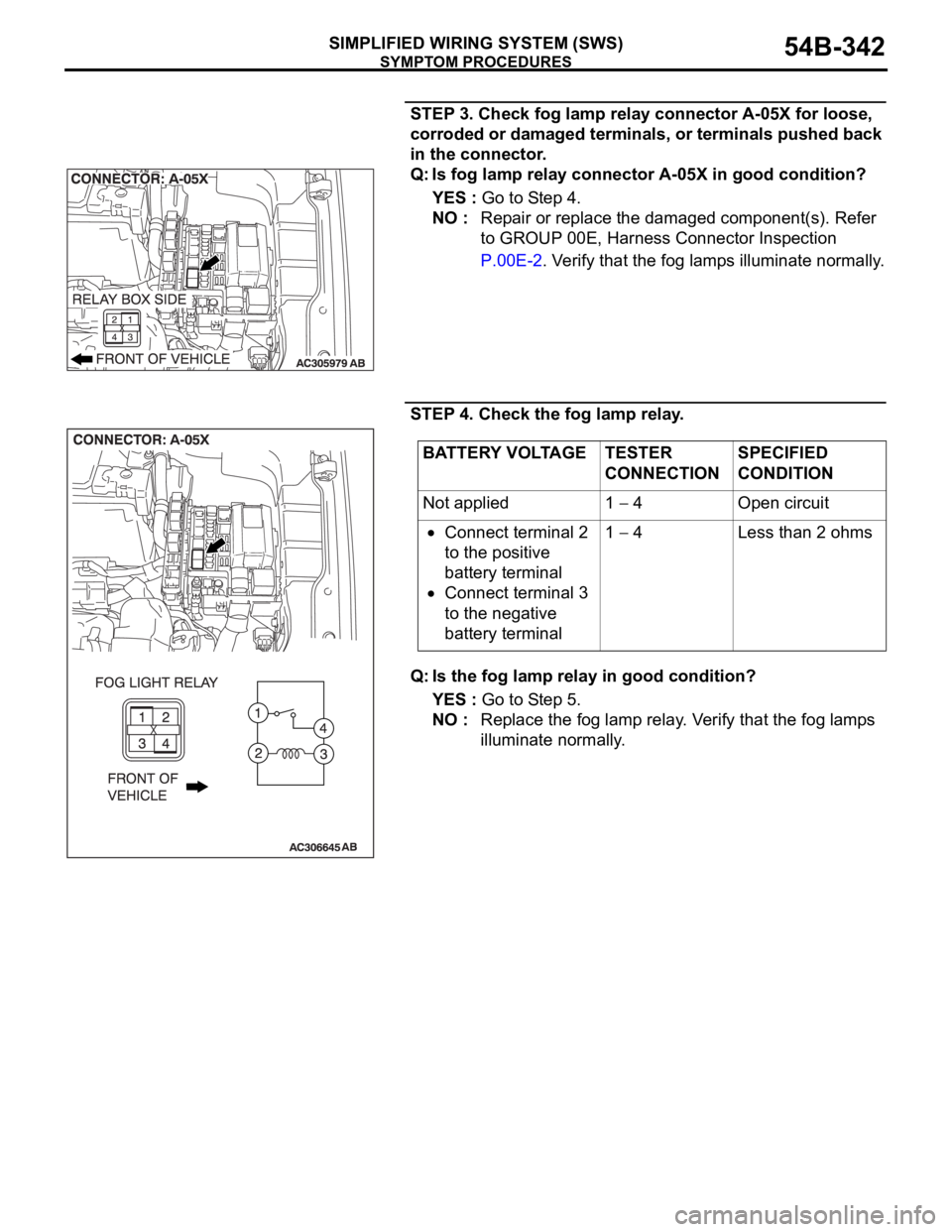
SYMPTOM PROCEDURES
SIMPLIFIED WIRING SYSTEM (SWS)54B-342
STEP 3. Check fog lamp relay connector A-05X for loose,
corroded or damaged terminals, or terminals pushed back
in the connector.
Q: Is fog lamp relay connector A-05X in good condition?
YES : Go to Step 4.
NO : Repair or replace the damaged component(s). Refer
to GROUP 00E, Harness Connector Inspection
P.00E-2. Verify that the fog lamps illuminate normally.
STEP 4. Check the fog lamp relay.
Q: Is the fog lamp relay in good condition?
YES : Go to Step 5.
NO : Replace the fog lamp relay. Verify that the fog lamps
illuminate normally.
BATTERY VOLTAGE TESTER
CONNECTIONSPECIFIED
CONDITION
Not applied 1
4 Open circuit
Connect terminal 2
to the positive
battery terminal
Connect terminal 3
to the negative
battery terminal1
4 Less than 2 ohms
Page 343 of 1500
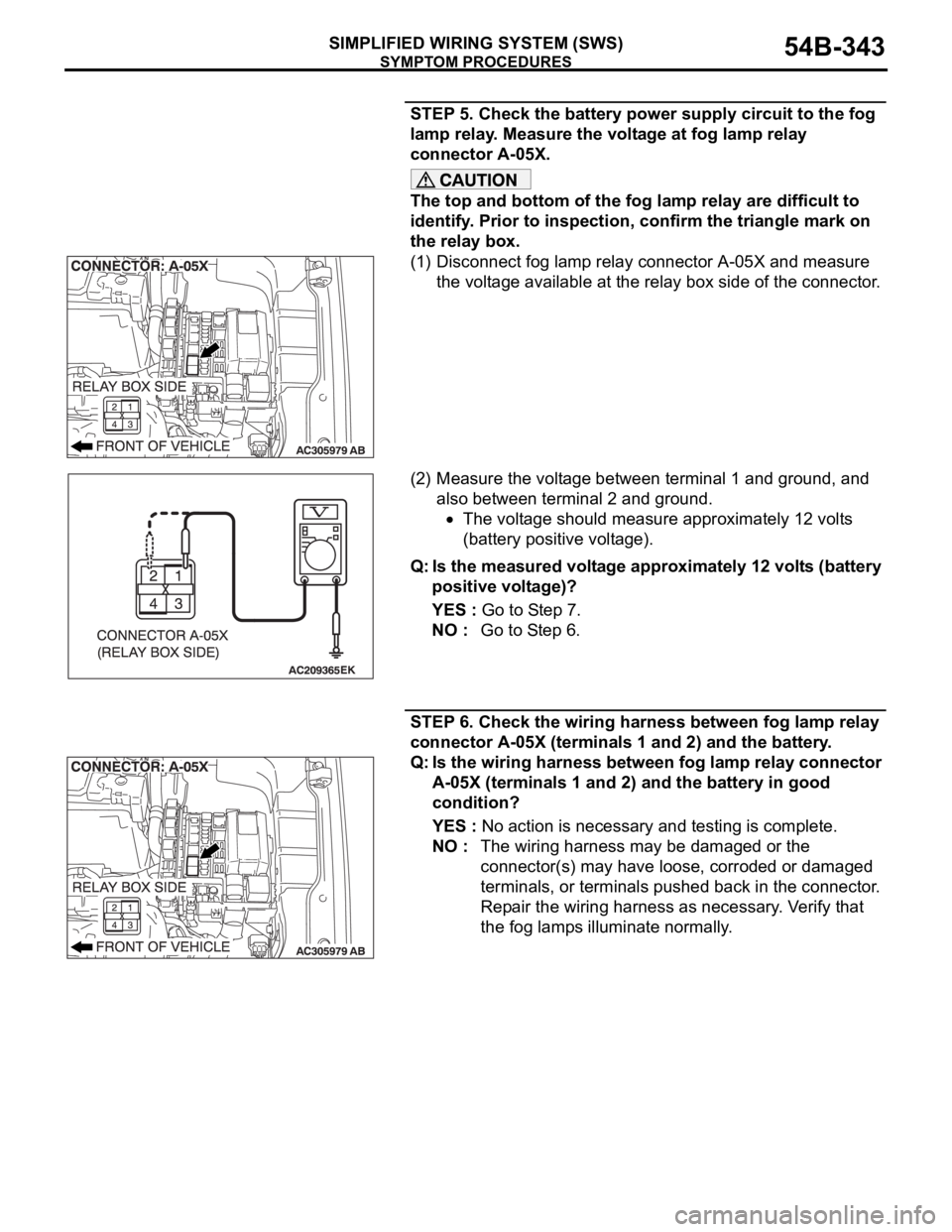
SYMPTOM PROCEDURES
SIMPLIFIED WIRING SYSTEM (SWS)54B-343
STEP 5. Check the battery power supply circuit to the fog
lamp relay. Measure the voltage at fog lamp relay
connector A-05X.
The top and bottom of the fog lamp relay are difficult to
identify. Prior to inspection, confirm the triangle mark on
the relay box.
(1) Disconnect fog lamp relay connector A-05X and measure
the voltage available at the relay box side of the connector.
(2) Measure the voltage between terminal 1 and ground, and
also between terminal 2 and ground.
The voltage should measure approximately 12 volts
(battery positive voltage).
Q: Is the measured voltage approximately 12 volts (battery
positive voltage)?
YES : Go to Step 7.
NO : Go to Step 6.
STEP 6. Check the wiring harness between fog lamp relay
connector A-05X (terminals 1 and 2) and the battery.
Q: Is the wiring harness between fog lamp relay connector
A-05X (terminals 1 and 2) and the battery in good
condition?
YES : No action is necessary and testing is complete.
NO : The wiring harness may be damaged or the
connector(s) may have loose, corroded or damaged
terminals, or terminals pushed back in the connector.
Repair the wiring harness as necessary. Verify that
the fog lamps illuminate normally.
Page 356 of 1500
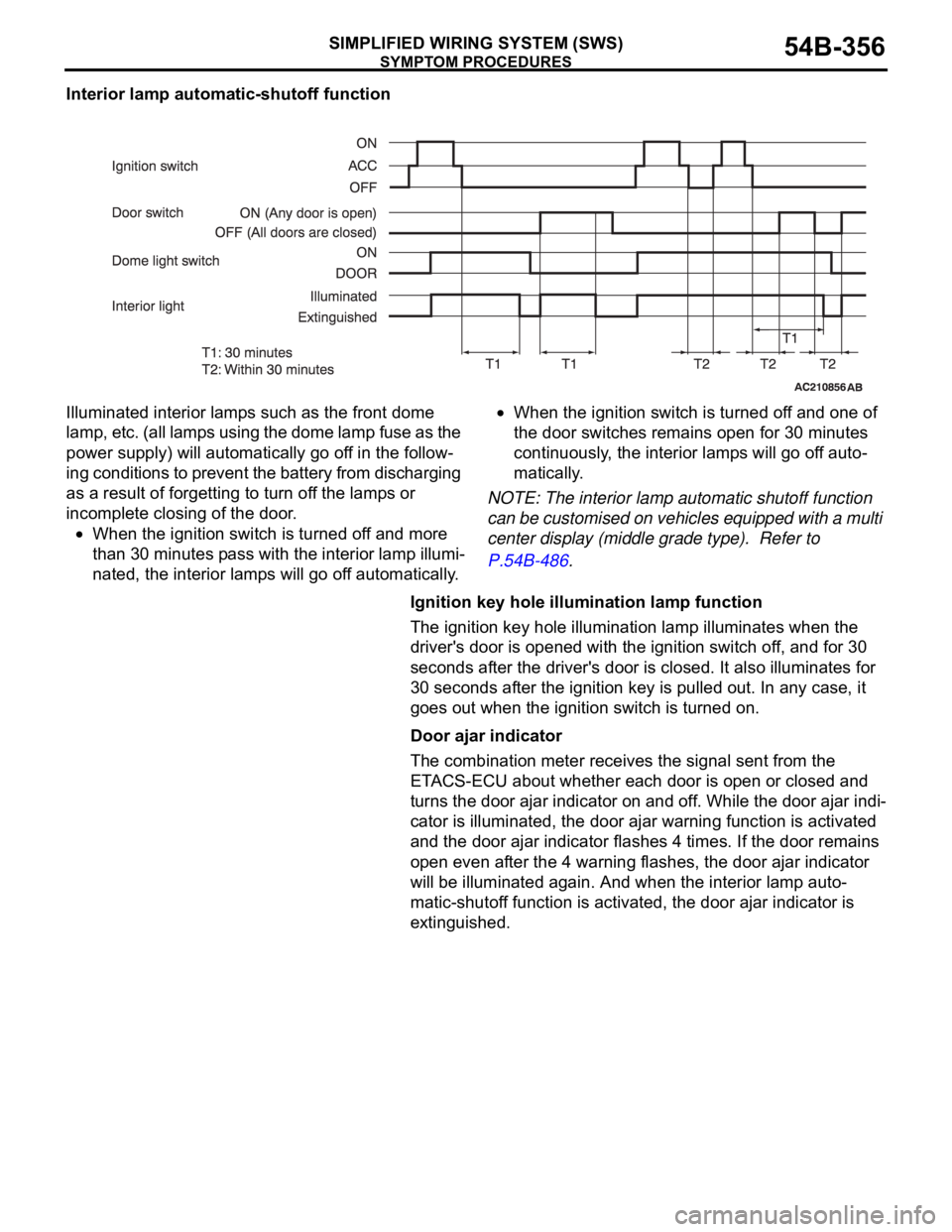
SYMPTOM PROCEDURES
SIMPLIFIED WIRING SYSTEM (SWS)54B-356
Interior lamp automatic-shutoff function
Illuminated interior lamps such as the front dome
lamp, etc. (all lamps using the dome lamp fuse as the
power supply) will automatically go off in the follow-
ing conditions to prevent the battery from discharging
as a result of forgetting to turn off the lamps or
incomplete closing of the door.
When the ignition switch is turned off and more
than 30 minutes pass with the interior lamp illumi-
nated, the interior lamps will go off automatically.
When the ignition switch is turned off and one of
the door switches remains open for 30 minutes
continuously, the interior lamps will go off auto-
matically.
NOTE: The interior lamp automatic shutoff function
can be customised on vehicles equipped with a multi
center display (middle grade type). Refer to
P.54B-486.
Ignition key hole illumination lamp function
The ignition key hole illumination lamp illuminates when the
driver's door is opened with the ignition switch off, and for 30
seconds after the driver's door is closed. It also illuminates for
30 seconds after the ignition key is pulled out. In any case, it
goes out when the ignition switch is turned on.
Door ajar indicator
The combination meter receives the signal sent from the
ETACS-ECU about whether each door is open or closed and
turns the door ajar indicator on and off. While the door ajar indi-
cator is illuminated, the door ajar warning function is activated
and the door ajar indicator flashes 4 times. If the door remains
open even after the 4 warning flashes, the door ajar indicator
will be illuminated again. And when the interior lamp auto-
matic-shutoff function is activated, the door ajar indicator is
extinguished.
Page 387 of 1500
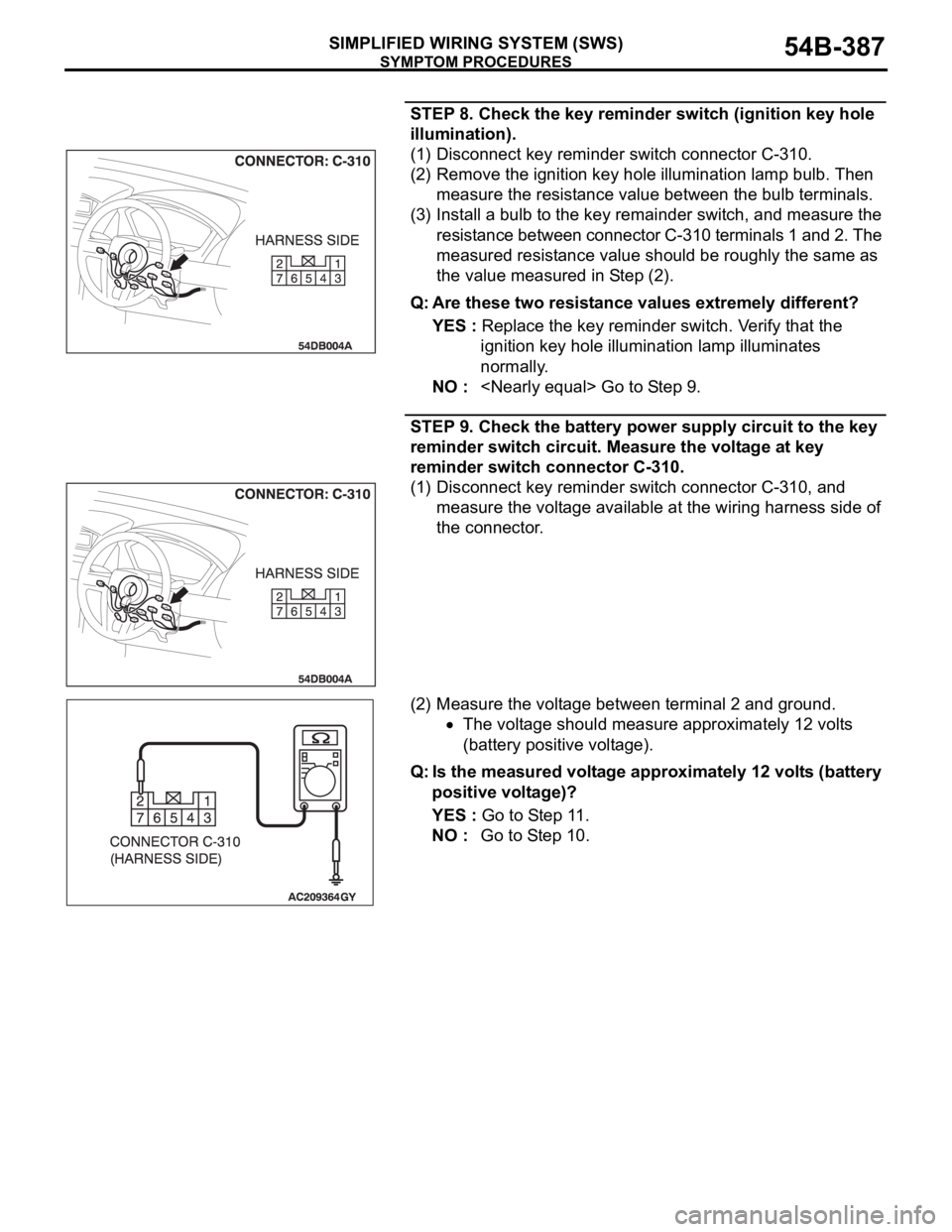
SYMPTOM PROCEDURES
SIMPLIFIED WIRING SYSTEM (SWS)54B-387
STEP 8. Check the key reminder switch (ignition key hole
illumination).
(1) Disconnect key reminder switch connector C-310.
(2) Remove the ignition key hole illumination lamp bulb. Then
measure the resistance value between the bulb terminals.
(3) Install a bulb to the key remainder switch, and measure the
resistance between connector C-310 terminals 1 and 2. The
measured resistance value should be roughly the same as
the value measured in Step (2).
Q: Are these two resistance values extremely different?
YES : Replace the key reminder switch. Verify that the
ignition key hole illumination lamp illuminates
normally.
NO :
STEP 9. Check the battery power supply circuit to the key
reminder switch circuit. Measure the voltage at key
reminder switch connector C-310.
(1) Disconnect key reminder switch connector C-310, and
measure the voltage available at the wiring harness side of
the connector.
(2) Measure the voltage between terminal 2 and ground.
The voltage should measure approximately 12 volts
(battery positive voltage).
Q: Is the measured voltage approximately 12 volts (battery
positive voltage)?
YES : Go to Step 11.
NO : Go to Step 10.
Page 388 of 1500
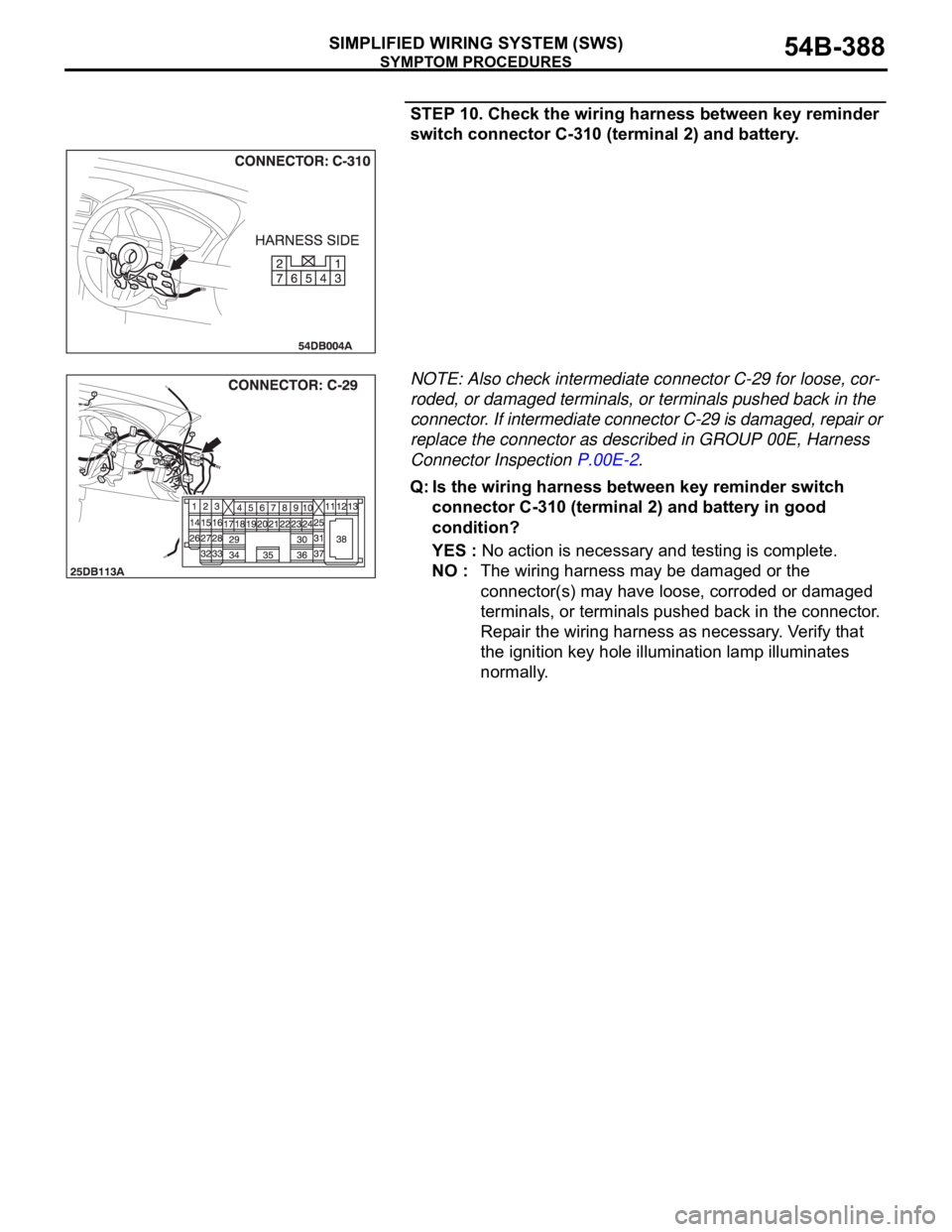
SYMPTOM PROCEDURES
SIMPLIFIED WIRING SYSTEM (SWS)54B-388
STEP 10. Check the wiring harness between key reminder
switch connector C-310 (terminal 2) and battery.
NOTE: Also check intermediate connector C-29 for loose, cor-
roded, or damaged terminals, or terminals pushed back in the
connector. If intermediate connector C-29 is damaged, repair or
replace the connector as described in GROUP 00E, Harness
Connector Inspection P.00E-2.
Q: Is the wiring harness between key reminder switch
connector C-310 (terminal 2) and battery in good
condition?
YES : No action is necessary and testing is complete.
NO : The wiring harness may be damaged or the
connector(s) may have loose, corroded or damaged
terminals, or terminals pushed back in the connector.
Repair the wiring harness as necessary. Verify that
the ignition key hole illumination lamp illuminates
normally.